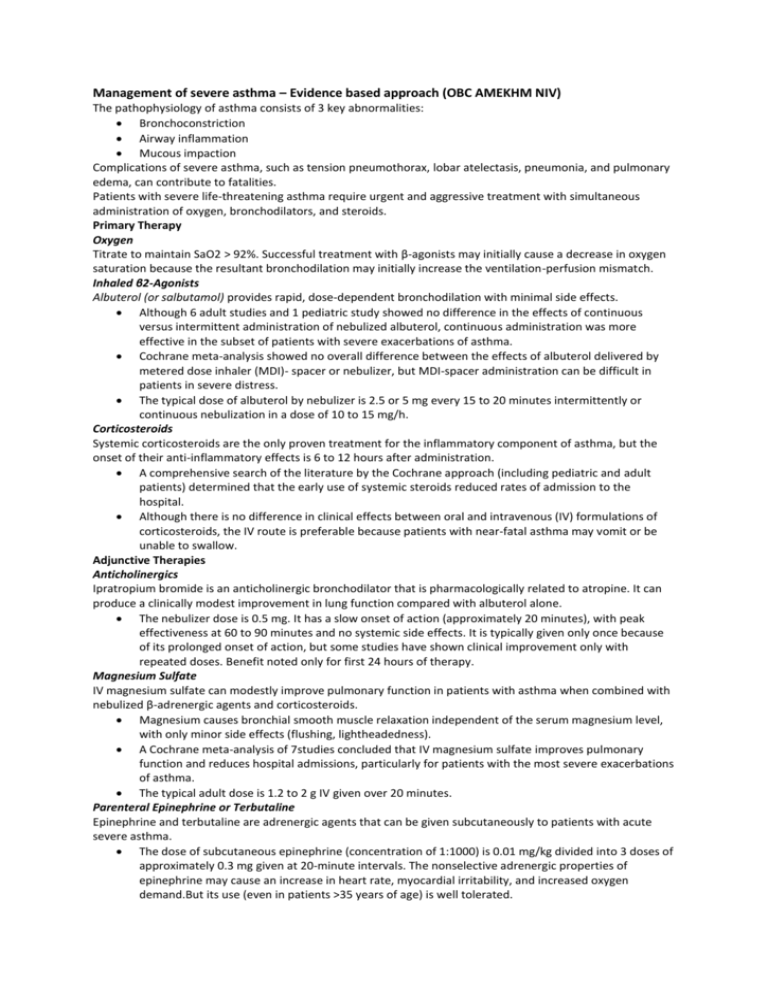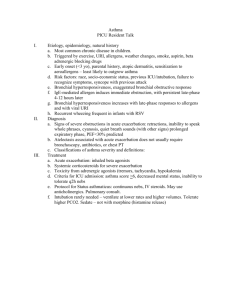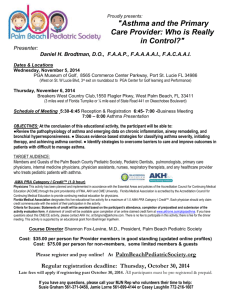Asthma ilcor EBM
advertisement

Management of severe asthma – Evidence based approach (OBC AMEKHM NIV) The pathophysiology of asthma consists of 3 key abnormalities: Bronchoconstriction Airway inflammation Mucous impaction Complications of severe asthma, such as tension pneumothorax, lobar atelectasis, pneumonia, and pulmonary edema, can contribute to fatalities. Patients with severe life-threatening asthma require urgent and aggressive treatment with simultaneous administration of oxygen, bronchodilators, and steroids. Primary Therapy Oxygen Titrate to maintain SaO2 > 92%. Successful treatment with β-agonists may initially cause a decrease in oxygen saturation because the resultant bronchodilation may initially increase the ventilation-perfusion mismatch. Inhaled β2-Agonists Albuterol (or salbutamol) provides rapid, dose-dependent bronchodilation with minimal side effects. Although 6 adult studies and 1 pediatric study showed no difference in the effects of continuous versus intermittent administration of nebulized albuterol, continuous administration was more effective in the subset of patients with severe exacerbations of asthma. Cochrane meta-analysis showed no overall difference between the effects of albuterol delivered by metered dose inhaler (MDI)- spacer or nebulizer, but MDI-spacer administration can be difficult in patients in severe distress. The typical dose of albuterol by nebulizer is 2.5 or 5 mg every 15 to 20 minutes intermittently or continuous nebulization in a dose of 10 to 15 mg/h. Corticosteroids Systemic corticosteroids are the only proven treatment for the inflammatory component of asthma, but the onset of their anti-inflammatory effects is 6 to 12 hours after administration. A comprehensive search of the literature by the Cochrane approach (including pediatric and adult patients) determined that the early use of systemic steroids reduced rates of admission to the hospital. Although there is no difference in clinical effects between oral and intravenous (IV) formulations of corticosteroids, the IV route is preferable because patients with near-fatal asthma may vomit or be unable to swallow. Adjunctive Therapies Anticholinergics Ipratropium bromide is an anticholinergic bronchodilator that is pharmacologically related to atropine. It can produce a clinically modest improvement in lung function compared with albuterol alone. The nebulizer dose is 0.5 mg. It has a slow onset of action (approximately 20 minutes), with peak effectiveness at 60 to 90 minutes and no systemic side effects. It is typically given only once because of its prolonged onset of action, but some studies have shown clinical improvement only with repeated doses. Benefit noted only for first 24 hours of therapy. Magnesium Sulfate IV magnesium sulfate can modestly improve pulmonary function in patients with asthma when combined with nebulized β-adrenergic agents and corticosteroids. Magnesium causes bronchial smooth muscle relaxation independent of the serum magnesium level, with only minor side effects (flushing, lightheadedness). A Cochrane meta-analysis of 7studies concluded that IV magnesium sulfate improves pulmonary function and reduces hospital admissions, particularly for patients with the most severe exacerbations of asthma. The typical adult dose is 1.2 to 2 g IV given over 20 minutes. Parenteral Epinephrine or Terbutaline Epinephrine and terbutaline are adrenergic agents that can be given subcutaneously to patients with acute severe asthma. The dose of subcutaneous epinephrine (concentration of 1:1000) is 0.01 mg/kg divided into 3 doses of approximately 0.3 mg given at 20-minute intervals. The nonselective adrenergic properties of epinephrine may cause an increase in heart rate, myocardial irritability, and increased oxygen demand.But its use (even in patients >35 years of age) is well tolerated. Ketamine Ketamine is a parenteral dissociative anesthetic that has bronchodilatory properties. Ketamine may also have indirect effects in patients with asthma through its sedative properties. Heliox Heliox is a mixture of helium and oxygen (usually a70:30 helium to oxygen ratio mix) that is less viscous than ambient air. Heliox has been shown to improve the delivery and deposition of nebulized albuterol. Although recent meta-analysis of 4 clinical trials did not support the use of heliox in the initial treatment of patients with acute asthma, it may be useful for asthma that is refractory to conventional therapy. The heliox mixture requires at least 70% helium for effect, so if the patient requires >30% oxygen, the heliox mixture cannot be used. Methylxanthines Methylxanthines are infrequently used because of erratic pharmacokinetics and known side effects. Inhaled Anesthetics Case reports in adults and children suggest a benefit of inhalation anesthetics for patients with status asthmaticus unresponsive to maximal conventional therapy. These anesthetic agents may work directly as bronchodilators and may have indirect effects by enhancing patient-ventilator synchrony and reducing oxygen demand and carbon dioxide production. Assisted Ventilation Noninvasive Positive-Pressure Ventilation Noninvasive positive-pressure ventilation (NIPPV) may offer short-term support to patients with acute respiratory failure and may delay or eliminate the need for endotracheal intubation. This therapy requires an alert patient with adequate spontaneous respiratory effort. Bi-level positive airway pressure (BiPAP), the most common way of delivering NIPPV, allows for separate control of inspiratory and expiratory pressures. Two small randomised studies have shown benefit of early use in mild to moderate exacerbations but no studies to date in severe cases. Endotracheal Intubation with Mechanical Ventilation Endotracheal intubation does not solve the problem of small airway constriction in patients with severe asthma. In addition, intubation and positive-pressure ventilation can trigger further bronchoconstriction and complications such as breath stacking (auto-PEEP [positive end-expiratory pressure]) and barotrauma. Although endotracheal intubation introduces risks, elective intubation should be performed if the asthmatic patient deteriorates despite aggressive management. Use largest ETT available to decrease airway resistance (8-9). Confirm tube placement early and obtain CXR early. Ventilator settings Slower respiratory rates – 6-10/min Smaller tidal volumes – 6-8ml/kg Shorter inspiratory time – flow rate 80-100ml/min Longer expiratory time – 1:4 or 1:5, Pplat <30cm h2o Permissive Hypercapnia Sedation and paralysis as needed to improve ventilator synchrony Causes for deterioration when on ventilation DOPE – Displacement(tube), Obstruction, Pneumothorax and Equipment failure If the patient with asthma deteriorates or is difficult to ventilate, verify endotracheal tube position, eliminate tube obstruction (eliminate any mucous plugs and kinks), and rule out (or decompress) a pneumothorax. Only experienced providers should perform needle decompression or insertion of a chest tube for pneumothorax Check the ventilator circuit for leaks or malfunction. High end-expiratory pressure can be quickly reduced by separating the patient from the ventilator circuit; this will allow PEEP to dissipate during passive exhalation. To minimize auto-PEEP, decrease inhalation time (this increases exhalation time), decrease the respiratory rate by 2 breaths per minute, and reduce the tidal volume to 3 to 5 mL/kg. Continue treatment with inhaled albuterol.









